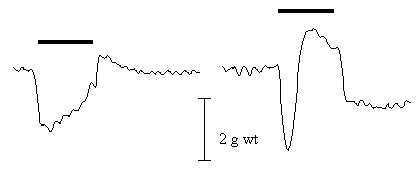| pA2 online © Copyright 2004 The British Pharmacological Society |
047P
GKT, University of London Winter Meeting December 2003 |
|
Further
evidence for noradrenergic nerves contributing to neurogenic responses
of the sheep isolated internal anal sphincter |
|
We have previously shown that brief electrical stimulation (1-20 Hz, 1s) of sheep internal anal sphincter causes neurogenic relaxations of myogenic tone (Mundey et al., 2000). The responses were inhibited by L-NAME and uncovered phentolamine-sensitive contractions at higher frequencies. Thus, neurogenic responses appear to involve both nitric oxide and noradrenaline. We have examined the effect of a longer duration of field stimulation, at a wider range of frequencies, and the effect of the bretylium, an adrenergic neurone blocker (Herrting et al., 1961), on these responses.
Segments of sheep isolated internal anal sphincter were prepared for isometric tension recording (Mundey et al., 2000). Neurogenic responses to 1 and 30 Hz stimulation (300 mA, 0.3 ms, 30 s duration) were examined in the absence and presence of 30µM bretylium. The effect of bretylium was then examined in the presence of L-NAME. The magnitude of responses is in gram weight and shown as the mean ± s.e.mean of n observations. The time course of neurogenic relaxations is expressed as the time taken from the cessation of field stimulation for a 50% decline in maximal relaxation (t50).
Figure 1 shows that electrical stimulation caused sustained neurogenic relaxations at 1Hz (1.72±0.19 g wt; t50 3.8±0.8 sec, n=41). However, at 30Hz stimulation the relaxations (1.69± 0.16 g wt, n=38) were transient (t50 -15.4±1.8 sec, n=38) and followed by a large contraction in 75% of preparations (2.31±0.16 g wt, n=31).

Figure 1: Digitized recording of the response of the sheep anal sphincter to 1Hz (Left) and 30Hz (Right) stimulation for 30s.
Following the addition of bretylium (30 µM), stimulation at 1Hz elicited a relaxation similar to the control (1.51± 0.17 g wt, n=40) and t50 (2.9±0.9 sec, n=40). At 30 Hz stimulation the magnitude of the relaxation was increased (2.05 ± 0.18g wt, n=38), and the t50 prolonged (-3.6±1.6 sec, n=38); the delayed neurogenic contraction was abolished (Student t-test p < 0.05). Subsequent addition of L-NAME (100 µM) in the presence of 30µM bretylium, significantly reduced responses at 1 Hz (0.2 ± 0.11 g wt, n=14) and 30 Hz (0.54 ± 0.17 g wt, n=13).
These results confirm that low frequencies of electrical field stimulation selectively activate nitrergic nerve. However, as evidenced by the transient nature of the relaxation and the appearance of delayed contractions, higher frequencies of stimulation may involve other transmitters. The action of bretylium is consistent with a significant role for noradrenaline and, in the presence of L-NAME, suggests the presence a third, unidentified transmitter.
Hertting, G. et al.,
(1961). Br. J. Pharmacol., 18, 161-166.
Mundey M. et al., (2000) Br. J. Pharmacol & Chemother. 130, 489-94.